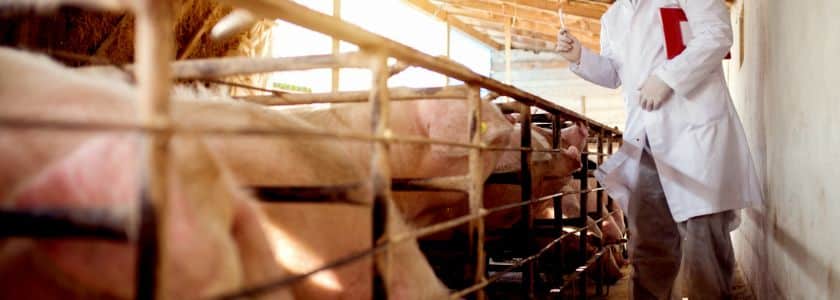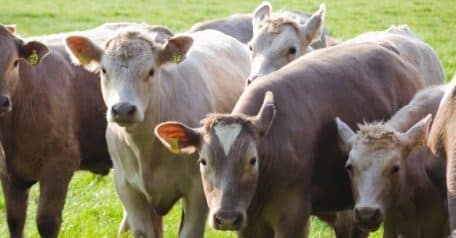The Takeaway: CRISPR gene editing technology has been used in many animals in recent years, but most of the action has been pure research. Now, researchers have edited the genomes of pigs so they resist a deadly virus, and those pigs are inching closer to winding up on your dining room table.
Pigs gifted us the primary material for footballs, the main characters in fairy tales, gelatin, and the occasional organ for human transplant. Now, they’re about to gift us something entirely different—the CRISPR-edited meal.
A U.K. company is on the verge of U.S. Food and Drug Administration approval of a gene-edited pig that will be available for widespread human consumption.
The company, Genus, gene edited pigs so they are resistant to a virus that kills pigs easily and can devastate local swine industries. The FDA sees the DNA changes made by CRISPR as an “investigational new drug” and so is requiring the company to show that the genomic changes are stable and do in fact result in a virus resistance.
Genus edited pig genomes to combat a deadly virus that attacks young pigs. That virus, called porcine reproductive and respiratory syndrome (PRRS), is global and costs the industry billions. (Learn more about using CRISPR to combat world hunger here.) Research findings several years ago identified the ability of CRISPR to disable a receptor in pig cells called CD163 that the virus relies on to establish the infection.
How is CRISPR used in pigs?
CRISPR, which stands for clustered regularly interspaced short palindromic repeats, is a revolutionary gene-editing tool (though not too revolutionary) that allows scientists to make precise changes to an organism's DNA. In pigs, CRISPR technology has been utilized for various purposes, primarily in agricultural and biomedical research contexts. Here's how CRISPR is used in pigs:
- Disease resistance: One application of CRISPR in pigs is to develop disease-resistant breeds. By editing specific genes associated with susceptibility to certain diseases, researchers aim to create pigs that are more resistant to common ailments. For example, scientists have targeted genes associated with viral infections like PRRS and African Swine Fever (ASF), aiming to produce pigs with enhanced resistance to these diseases.
- Improved animal welfare: CRISPR can also be used to improve animal welfare by reducing the occurrence of genetic defects or susceptibility to certain conditions. By editing genes associated with traits like stress resistance, resilience to harsh environmental conditions, or improved feed conversion efficiency, researchers aim to enhance the overall health and well-being of pigs.
- Biomedical research: Pigs are widely used as biomedical models due to their physiological similarities to humans. CRISPR technology allows researchers to introduce specific genetic modifications in pigs to better understand human diseases and develop new treatments. For example, pigs with genetic modifications relevant to conditions such as cardiovascular disease, diabetes, or organ transplantation have been created to study these diseases and test potential therapies.
- Organ transplant: One of the significant breakthroughs facilitated by CRISPR in pigs is the potential for xenotransplantation, the transplantation of organs or tissues from one species to another. Pigs are considered promising donor candidates for human organ transplantation due to their physiological similarities to humans. CRISPR enables the modification of pig organs to make them more compatible with the human immune system, potentially overcoming issues of rejection and compatibility.
- Production efficiency: In agricultural settings, CRISPR can be used to enhance production efficiency in pigs by modifying genes related to traits such as growth rate, meat quality, or reproductive performance. By creating pigs with desired genetic characteristics, farmers can improve productivity and economic outcomes.
What animals has CRISPR been used in?
CRISPR technology has been applied to a wide range of animals for various purposes, including biomedical research, agriculture, and conservation. Some of the animals in which CRISPR has been used include:
Mice: Mice are one of the most commonly genetically engineered animals for biomedical research. CRISPR has been extensively used in mice to study gene function, model human diseases, and develop potential treatments.
Rats: Like mice, rats are commonly used in biomedical research. CRISPR has been employed in rats for similar purposes, including disease modeling and functional genomics studies.
Pigs: Pigs are used in biomedical research, xenotransplantation studies, and agriculture. CRISPR has been used in pigs to introduce disease resistance, improve production traits, and develop pig models for human diseases.
Cattle: Cattle are an important livestock species used for meat and dairy production. CRISPR technology has been used in cattle for purposes such as improving disease resistance, enhancing production traits, and developing models for human diseases.
Sheep: Sheep are used in agriculture for wool and meat production. CRISPR has been applied in sheep to introduce beneficial traits, such as disease resistance or improved wool quality.
Fish: Fish species, including zebrafish and salmon, are used in biomedical research, aquaculture, and ecological studies. CRISPR has been used in fish to study gene function, develop disease models, and improve traits relevant to aquaculture.
Non-human primates: Non-human primates, such as monkeys and marmosets, are used in biomedical research due to their genetic and physiological similarities to humans. CRISPR has been employed in non-human primates to study gene function, model human diseases, and explore potential therapies.
Insects: Insects, including fruit flies and mosquitoes, are used in genetic research and vector control efforts. CRISPR has been used in insects for gene function studies, genetic manipulation, and potential applications in pest control.
Birds: Birds such as chickens and quails are used in agriculture for meat and egg production. CRISPR technology has been applied in birds to introduce desirable traits, such as disease resistance, and to study avian biology.
Dogs: Dogs are used as models for studying genetic diseases and behavior. CRISPR has been used in dogs to study gene function, model genetic disorders, explore potential treatments, and prolong the life of our beloved pets.
Hamsters: Researchers used CRISPR to block a neurochemical signaling pathway in Syrian hamsters, but found that doing so changed their behavior in unexpected ways.
Is using CRISPR in animals safe?
The safety of using CRISPR in animals is a complex and evolving topic that involves scientific, ethical, and regulatory considerations. Here are some key points to consider regarding the safety of using CRISPR in animals:
- Off-target effects: One concern with CRISPR technology is the potential for off-target effects, where unintended changes are made to the genome in addition to the intended edits. While significant progress has been made in improving the specificity of CRISPR systems, off-target effects can still occur, and their potential consequences need to be carefully evaluated.
- Unintended consequences: Introducing genetic modifications into animals can have unintended consequences on their health, welfare, and behavior. It's essential to thoroughly assess the potential risks associated with specific genetic modifications and monitor the animals for any adverse effects over time.
- Ecological impact: In cases where genetically modified animals are released into the environment, there may be concerns about the ecological impact of these organisms. For example, genetically modified mosquitoes designed to control disease transmission could potentially affect non-target species or disrupt ecosystems. Evaluating and mitigating these risks are crucial aspects of ensuring the safety of CRISPR-modified animals.
- Ethical considerations: Ethical considerations surrounding the use of CRISPR in animals include issues such as animal welfare, consent (in the case of sentient animals), and potential impacts on biodiversity and ecosystems. These ethical concerns need to be carefully weighed against the potential benefits of genetic modification and addressed through transparent and responsible decision-making processes.
- Regulatory oversight: The use of CRISPR in animals is subject to regulatory oversight in many jurisdictions. Regulatory agencies assess the safety and ethical implications of proposed genetic modifications and may require extensive testing and risk assessments before genetically modified animals can be used in research or released into the environment.
- Long-term monitoring: Even after genetically modified animals have been created and introduced, long-term monitoring is essential to evaluate their safety and assess any unforeseen consequences of genetic modification. This monitoring may involve ongoing studies of the animals' health, behavior, and interactions with the environment.
Using CRISPR in pigs for human consumption
Genus, the U.K. company at the center of the current pig CRISPR project, specializes in breeding livestock with particular traits and, it was reported in early 2024, has taken a proof-of-concept idea to commercial scale. This real-world application, observers note, is ready to go to market. While vaccines exist for PRRS, they are not 100% effective.
So far, the FDA has approved two genetically modified animals that are consumed by humans—a salmon that grows faster and a pig that lacks a sugar molecule that some people are allergic to—but neither are widely consumed. Genus is currently working through the regulatory channels in many other countries, most of which are less restrictive than the U.S. but who also look to the U.S. for general guidance on such approvals.
How does IDT support CRISPR research?
IDT has a full suite of solutions to support CRISPR genome editing workflows. This includes:
- cGMP gRNA manufacturing: A streamlined and regulatory-compliant solution with comprehensive documentation that moves researchers to clinical success faster.
- Genome editing detection kit: For detection of on-target or known off-target CRISPR editing.
- CRISPR analysis: Fast, accurate quantification of genome editing results.
- HDR donor blocks: Tools that address homology-directed repair research solutions when creating larger genome changes.
- HDR donor oligos: DNA delivered to a cell to insert or change short DNA sequences in the target genome region.
- CRISPR libraries: RNA that permit high-through put screening of key molecular targets.
- CRISPR nucleases: Cas9 and Cas12a proteins.
- And more.
Want to learn more about CRISPR but not sure where to start? Our free CRISPR Basics Handbook gives you everything you need to know about CRISPR, from its history to applications, gRNA design tips, and Cas enzyme considerations. Get it here.

























